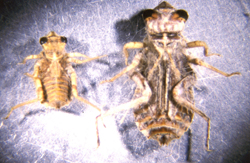 Aquatic Insects of Michigan
Aquatic Insects of Michigan
by Ethan Bright, Museum of Zoology Insect Division and School of Natural Resources and Environment
University of Michigan
- Home
- Species Lists
- Coleoptera
- Diptera
- Ephemeroptera
- Acanthametropodidae
- Ameletidae
- Ametropodidae
- Arthropleidae
- Baetidae
- Baetiscidae
- Behningiidae
- Caenidae
- Ephemerellidae
- Ephemeridae
- Heptageniidae
- Isonychiidae
- Leptohyphidae
- Leptophlebiidae
- Metretopodidae
- Neoephemeridae
- Oligoneuriidae
- Palingeniidae
- Polymitarcyidae
- Potamanthidae
- Pseudironidae
- Siphlonuridae
- Heteroptera
- Hymenoptera
- Lepidoptera
- Megaloptera
- Neuroptera (Sisyridae)
- Odonata
- Orthoptera
- Plecoptera
- Trichoptera
- Other Orders
- Keys/Identification
- Aquatic Insects of Michigan
Erythemis Hagen, 1861 (Libellulidae) (Pondhawks) of Michigan - Identification
Of the 8 species of this primarily Neotropical genus found north of Mexico, two widely distributed species - Erythemis simplicicollis (Say, 1839) and E. vesiculosa (Fabricius, 1775) - occur in Michigan, most commonly in the southern half of the Lower Peninsula. E. vesiculosa has just recently been recorded in Ingham County, a first record for Michigan (Craves & O'Brien 2025). (Records also have been recorded from Lambton Co., Ontario, Essex Co. in Ohio, and Cook Co., Illinois, so it is not surprising a record from Michigan has finally been tallied).
Adults are moderate in size, greenish in appearance. Clear-winged, with a greenish face and black and green banded abdomen that fades in aging males. Legs are spiny. Nymphs are small and stocky larvae, often collected from loose, fine organic detritus in which they conceal themselves. Nymphs are easily distinguished from other Michigan libellulid nymphs by the decurved cerci and paraprocts, their prominently striped green and brown eyes (this striping remains noticeable in specimens preserved in alcohol for long periods of time), lack of mid-dorsal hooks and lateral spines on the abdomen, and long, spiny legs.
Erythemis simplicicolis is a common resident of marshy, often eutrophic ponds and lakes and sometimes slow sections of streams. Emergence in our area occurs usually from late-May through June. I have reared nymphs collected from Half-Moon Lake in Livingston Co., southern Michigan, in mid-April that emerged as adults in late May. In southern Michigan, larvae may be multivotine or evidenced two different populations. Ed Kormondy also collected two size classes of larvae on 15 September 1953 from South Lake in Washtenaw Co., clearly indicating two size classes: one specimen appeared ready to emerge (enlarged thorax, wing pads enlarged), another very small specimen that was clearly immature. Similarly to Perithemis tenera (Morin 1984, Wissinger 1988), voltinism may be influenced by fish predation and food resources.
Currently, no nymphal records of E. vesiculosa have been collected from Michigan, but undoubtedly they do occur and should be sought after.
Key to the Adults| 1a | a. Two rows of cells between veins Rs and Rspl | E. vesiculosa |
| b. Hindwing at least 38 mm long | ||
| 1b | a. One row of cells between veins Rs and Rspl | E. simplicicollis |
| b. Hindwing no more than 35 mm long | ||
Mature Nymphs
| 1a | a. Ab9 with distinct posterolateral spine, length 0.12-0.32 mm, decurved in lateral view | E. vesiculosa |
| b. Cerci in dorsal view notably curved outward | ||
| c. Dorsolateral rim of prementum with only fine pale setae | ||
| Also: Palpal setae 11-13, usually 12; metathoracic femur length 6.7-7.3mm; side of pterothorax with small, dark spiniform setae, conspicuous at 10x | ||
| 1b | a. Ab9 with posterolateral spine only a small, flat, triangular projection, length <0.10mm, straight in lateral view | E. simplicicollis |
| b. Cerci in dorsal view nearly straight, slightly curved outward | ||
| c. Dorsolateral rim of prementum with numerous stout setae in addition to fine pale setae | ||
| d. Also: Apex of epiproct in lateral view slightly decurved; Ratio of epiproct length:basal width 1.09-1.24, ratio of epiproct length:Ab9 middorsal length 1.63-1.77 | ||
References
Craves J, O'Brien D. 2025. Urban dragon hunters website. https://urbanodes.blogspot.com/2024/06/new-state-record-great-pondhawk.html, retrieved April 12, 2025.
Morin PJ. 1984. The impact of fish exclusion on the abundance and species composition of larval odonates: results of short-term experiments in a North Carolina farm pond. Ecology 65: 53-60.
Needham JG, Westfall MJ, May ML. 2010. Dragonflies of North America. The Odonata (Anisoptera) fauna of Canada, the Continential United States, Northern Mexico and the Great Antilles. Third Edition. Scientific Publishers: Gainesville, Florida. xiv + 658.
Paulson D. 2011. Dragonflies and damselflies of the East. Princeton Field Guides. Princeton University Press, Pinceton, New Jersey, USA. 538 p.
Tennessen KJ. 2019. Dragonfly nymphs of North America: An identificatgion guide. Springer Nature Switzerland, Cham, Switzerland. xiv + 620 p.
Walker EM, Corbet JS. 1975. The Odonata of Canada and Alaska, Vol. 3. University of Toronto Press: Toronto, Ontario. xvi + 308.
Wissinger SA. 1988. Spatial distribution, life history and estimates of survivorship in a fourteen- species assemblage of larval dragonflies. Freshwater Biology 20: 329-340.
Page created: July 17, 1998 - Last updated: April 12, 2025 (EB)